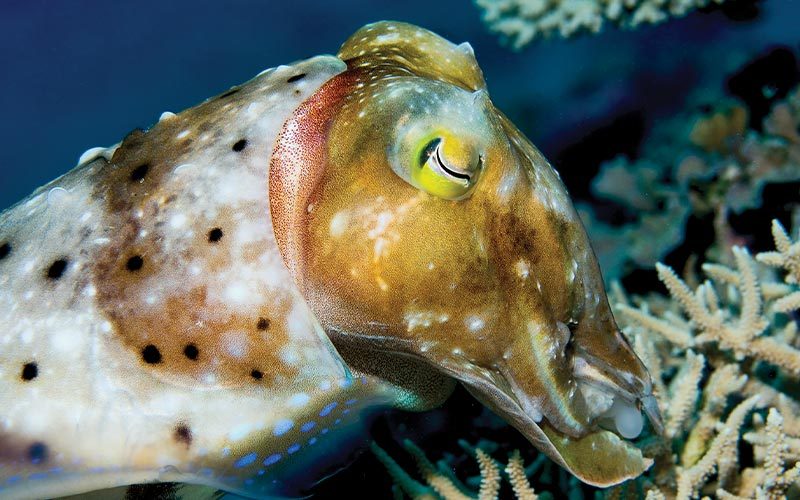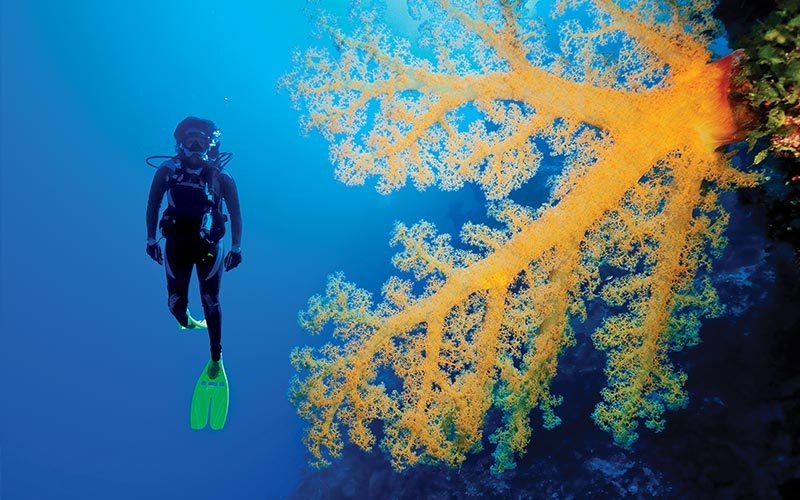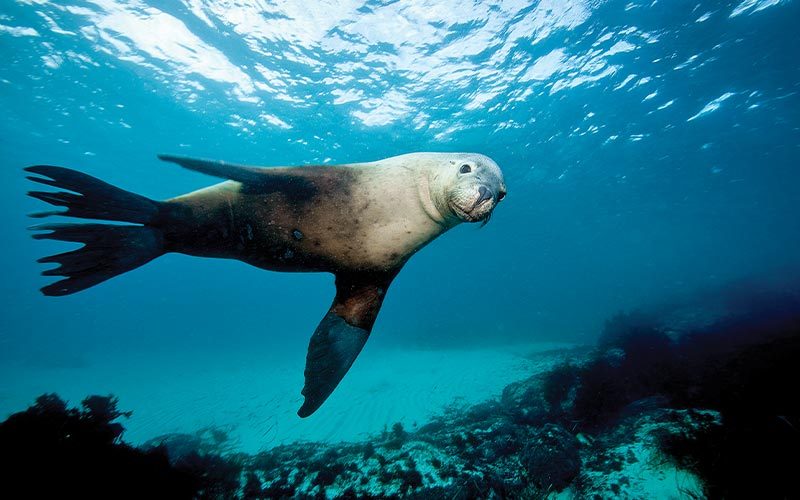A geographic overview lends quick insight into why Australia is so very special to dive enthusiasts. The world’s smallest continent is also its largest island, with 21,262 miles of coastline and 8,222 islands and islets.
Australia is bounded by the Indian Ocean along its west coast, the South Pacific Ocean to its east, the Great Southern Ocean to the south and the Timor Sea along the north (separating it from Indonesia and Papua New Guinea); its marine environments are inevitably diverse and spectacular. As testament to the eclectic biodiversity, Australia is home to 4,200 species of fish (an astounding 90 percent are endemic), 4,000 species of mollusks and 427 hard coral species. Clearly, there is much to see beneath the waters of Oz.
Here are highlights by specific dive regions.
The Great Barrier Reef
Located off Queensland, along Australia’s northeast coast, the Great Barrier Reef is the largest coral reef system in the world, easily visible even from space. Some of the more iconic and oft-visited sites are accessible from Cairns or Port Douglas, including the Ribbon Reefs and Australia’s marquee underwater attraction, the Cod Hole. The more remote and offshore reefs, such as Great Detached Reef to the far north and Osprey Reef in the Coral Sea, are purely liveaboard destinations.

The Cod Hole is one of the most-dived locations on the Great Barrier Reef, receiving some 18,000 divers a year; yet its coral gardens are lush and thriving with abundant marine life. The stars are the potato cod (Epinephalus tukula), a huge and charismatic grouper that can reach up to 7 feet in length and weigh more than 250 pounds. The cod are resident, and though their population can vary between four and 10 individuals, there are always inquisitive cod to welcome visiting divers.
For the big animal enthusiast, shark attraction (read: feeding) dives at Osprey Reef offer high-voltage proximity to whitetip, gray reef, blacktip, tawny nurse silvertip and even the rare appearance by great hammerhead sharks. Yet the most thrilling encounter in the Queensland region is snorkeling with dwarf minke whales (Balaenoptera acutorostrata). From May to August, dwarf minke whales appear in the waters around the Ribbon Reefs north of Cooktown, and strict regulations require that all encounters occur entirely at the discretion of the whale.

Here’s how it works: Snorkelers enter the water and hold onto a long line attached to a buoy, relying on the natural curiosity of the whale to draw the cetaceans closer. The whale trips are combined with visits to the Cod Hole and to premier dive sites such as Pixie’s Pinnacle and Steve’s Bommie to round out a ‘best-of’ Great Barrier Reef itinerary.
Sydney
For most visitors to Australia, Sydney is both the country’s port of entry and a respite before further travels in-country. Its topside attractions include the world’s largest natural harbor, transected by the spectacular Harbour Bridge, and the iconic Sydney Opera House. But what most divers don’t know is that the Sydney area includes some interesting diving.
The ferryboat to Manly, New Zealand, provides easy access to dive shops serving the Cabbage Tree Bay Marine Reserve. Shelly Beach and Fairy Bower are two overlapping sites with many endemic species close to shore, including the bizarre weedy sea dragon (Phyllopteryx taeniolatus), Port Jackson and wobbegong sharks, giant blue groper, old wives (the fish), squid and rays. It is also a spectacularly productive night dive, with many nocturnal creatures such as pyjama squid and giant cuttlefish. The underwater terrain is a mix of sand flats, boulders and long, sinuous, waving kelp. Sydney is also a great jumping-off point to two first-rate coastal dive locations: Jervis Bay to the south and Forster/Seal Rocks to the north. Be aware: The temperate waters off Sydney peak at 71°F. Bring adequate thermal protection.

South Australia
In addition to the world-class white shark diving near Port Lincoln (see “Great White Adventure” ), South Australia also boasts some excellent shore diving, mostly along piers and jetties built in the days before there were roads, when all supplies for the region arrived by cargo ship.
Depths rarely exceed 15 feet, and the pilings are encrusted with a kaleidoscope of colorful invertebrate species, providing a thriving marine ecosystem that includes crabs, shrimps, cephalopods, worms and small fish. The combination of the tall vertical structure provided by pilings, the constant shade provided by the pier decking and the continuous wash of tidal current flow makes for an oasis amid sand flats, seagrass beds and rubble fields of the inshore waters. Divers will commonly encounter blue-ringed octopus, ornate cowfish, stargazers, frogfish, cuttlefish, leatherjackets, pyjama squid and seahorses.

But the major attraction for diving South Australia piers are weedy sea dragons and leafy sea dragons (Phycodurus eques), the large and charismatic members of the seahorse family found only in Australian temperate waters. They can be found with relative ease in the seagrass beds near or under jetties, though their camouflage of appendages and coloration blend in so effectively with the seagrasses that it takes a trained eye to find them quickly. They are surprisingly large (up to 18 inches long), move slowly and are tolerant of divers if not harassed.
Of the 18 or so jetties in South Australia, the most popular to visit are Rapid Bay Jetty, Port Noarlunga Jetty, Tumby Bay Jetty and Edithburgh Jetty. Most have metal staircases that extend to below the low tide mark to enable divers easy access. For safety, bring a sharp dive knife or shears; fishing line entanglement is a common hazard.

Western Australia
Perth is one of Australia’s most vibrant cities and also perhaps the most remote metropolis in the world. It is as far as far gets, at least where the major airlines are concerned. For divers, the best action in Western Australia is yet another two-hour flight away: Exmouth.
Located 780 miles north of Perth, Exmouth bears the distinction of being the nearest town to the unique attraction of Ningaloo Reef, the world’s only fringing reef found on the west coast of a continent. All 160 miles of the reef are encompassed in the Ningaloo Marine Park, which boasts 220 species of coral, 500 species of fish, dugongs (Oz cousin to the manatee), sea turtles, potato cod and tiger sharks. But, clearly, Ningaloo Reef’s star attraction is the seasonal congregation of whale sharks.

From March until July, a sizeable population of whale sharks arrives at Ningaloo Reef. The reason: food. Seven to nine days after the full moon (during the neap tides in March) an astonishing 102 species of hard coral spawn simultaneously three to four hours after dark. During the same period, other broadcast spawners like polychaete worms, sea stars, mollusks and sea urchins also reproduce with all-out explosions of sperm and eggs. This superabundance of food is irresistible to filter feeders like whale sharks and manta rays.
Spotter planes locate whale sharks as they meander up and down the reef and then radio locations to waiting dive boats. Snorkelers enter the water in groups of 10, led by a guide who makes certain guests stay in compliance with marine park rules regarding whale shark encounters. Flash photography is not allowed, for example, and divers must avoid swimming in front of or touching the animals. In the May to October season, it’s also common to encounter large aggregations of manta rays and even humpback whales.
It would be a shame to visit Exmouth and not dive the Navy Pier, an installation built by the U.S. Navy in the 1960s and later handed over to Australia. Like so many artificial structures, the Navy Pier offers a shaded vertical and horizontal substrate for encrusting invertebrate life, which in turn attracts a tremendous variety of fish life. It seems that every fish and invertebrate species in the Indian Ocean can be found under this pier, from wobbegong sharks to frogfish to seahorses and nudibranchs. Divers have even seen dugongs there. Western Australia has further attractions to the north, both Rowley Shoals and Christmas Island have received raves from visiting divers.

© Alert Diver — Q1 Winter 2010